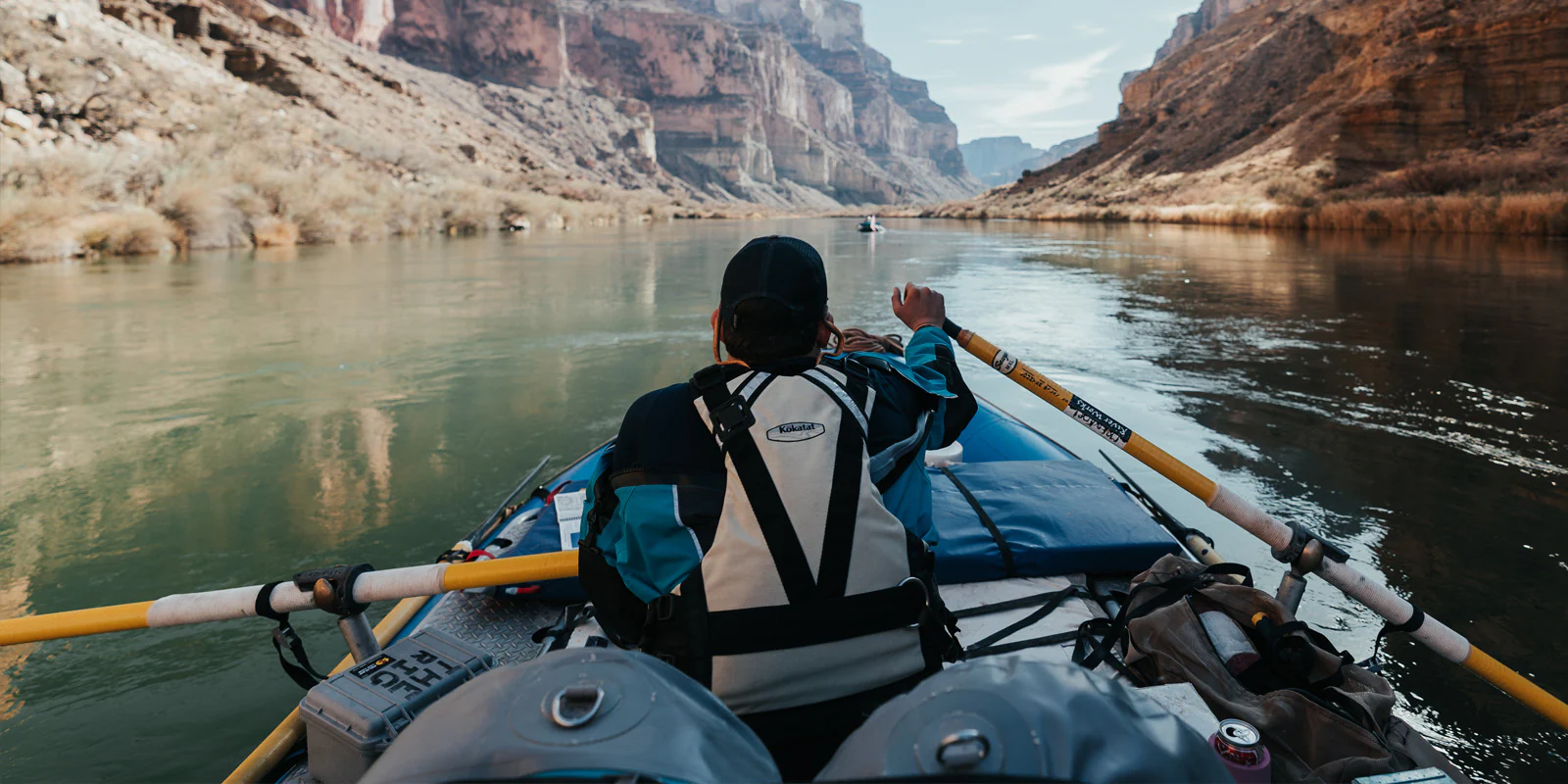If you’re into the outdoors and love the adrenaline rush of whitewater rafting, you’re probably curious about R2 rafting. It’s like taking rafting to the next level, where it’s just you and one other person paddling through rapids.
There’s no big crew, so it’s all about teamwork, communication, and really working with the river instead of trying to overpower it. Sounds awesome, right?
Let’s get into the details on how to make the most of your R2 rafting experience.
An Overview
| Specification | Details |
|---|---|
| Boat Size | 10.5′ to 13′ |
| Boat Type | Low-volume rafts or Paddle Cats |
| Ideal River Classes | Class II to Class V |
| Weight Capacity | 550 – 600 lbs |
| Number of Paddlers | 2 |
| Key Equipment | Helmet, Life Vest, Paddle |
| Communication Style | Real-time, Clear Commands |
| Safety Considerations | Flipping risk higher in smaller boats |
How Does R2 Rafting Work?
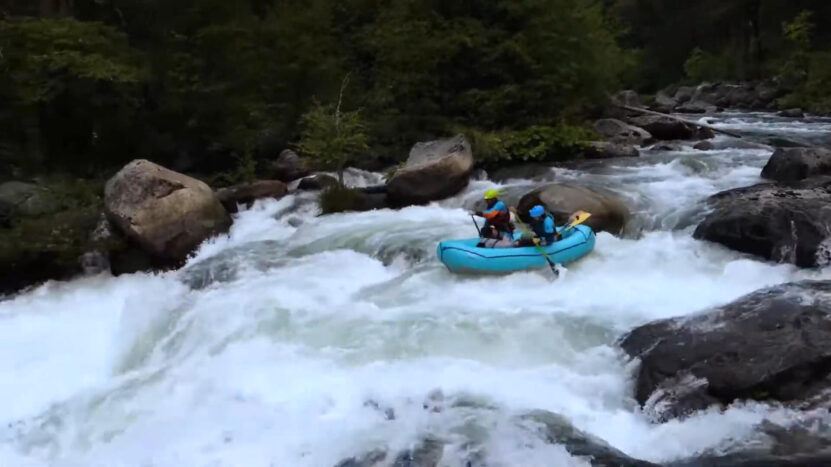
R2 rafting is all about you and one other person working together. It’s not complicated, but it does take some practice to get it right.
The Basics
- Paddling Together: The most important thing is syncing your strokes. If one of you paddles at the wrong time, you’ll probably end up spinning or going off course. So, match each other’s pace.
- Communication is Key: You gotta talk. Simple stuff like “left” or “right” works fine, but agree on the commands before you even get on the water. The clearer, the better. It’s not a guessing game.
- Let the River Do the Work: Instead of fighting the current, use it to your advantage. The river’s flow will do most of the work for you, and you just need to guide the raft in the right direction.
Getting the right gear is a big deal for R2 rafting. With only two people in the boat, you’re handling everything on your own, so it’s important to be prepared.Gear You Need for R2 Rafting
Raft Size and Type
- Raft Size: You’ll want something between 10.5 to 13 feet long. Anything bigger is too hard to control with just two people. Smaller boats are more agile and easier to steer in tight spots.
- Raft Type: Low-volume rafts are a great choice. They sit lower in the water and are easier to maneuver through rapids. Paddle cats are also a solid option if you’re on technical rivers, as they can squeeze through narrow spots where other boats might get stuck.
Essential Equipment
- Helmet: No question about it, always wear a helmet. You never know when the raft might flip or you get tossed into rocks.
- Life Vest: A good personal flotation device (PFD) is mandatory. Make sure it fits snugly but still allows you to move your arms freely for paddling.
- Paddle: You’re both going to need strong paddles, but they don’t need to be super heavy. Lightweight paddles are better for maintaining control and reducing fatigue on longer runs.
- Dry Bag: Keep your essentials like snacks, a first-aid kit, and maybe an extra layer of clothing in a dry bag. You don’t want anything important getting soaked.
Safety Gear
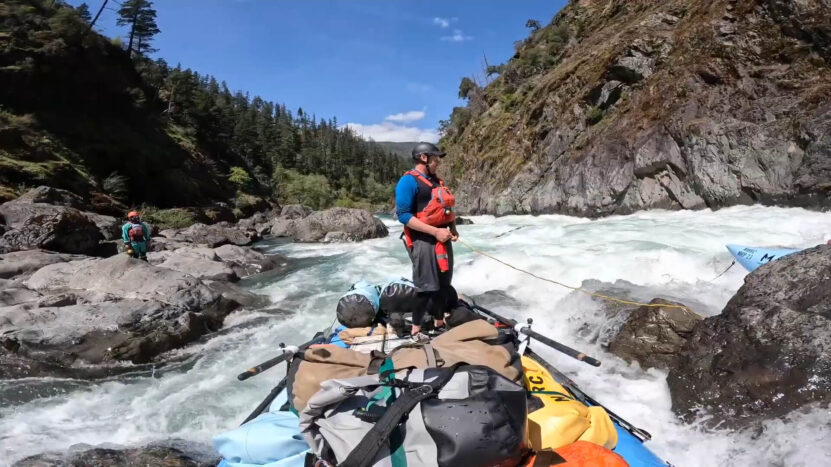
- Throw Bag: This is a key piece of safety gear in case someone goes overboard. It’s basically a rope you can throw to a swimmer to pull them back to the raft.
- Knife: A river knife is good for cutting ropes or straps if something gets tangled. It’s small, sharp, and can easily be strapped to your PFD for quick access.
- Flip Line: If the raft flips, a flip line helps you get it right-side up. It’s a simple tool but a lifesaver in those moments.
Optional but Helpful
- Neoprene Gloves: If you’re rafting in colder water, neoprene gloves will keep your hands warm and give you a better grip on the paddle.
- Neoprene Boots: These are great for keeping your feet warm and protected, especially if you end up swimming in cold water.
Best Rivers for R2 Rafting
R2 rafting works best on rivers that offer a mix of technical challenges and fun rapids. Some spots are better suited for two-person rafting than others because of the water flow, obstacles, and accessibility.
Here’s a list of some top places you should check out.
Arkansas River, Colorado
This river offers everything from Class II to Class V rapids, making it perfect for beginners and seasoned rafters. The Arkansas River is also known for its tight spots and technical runs, which are ideal for smaller R2 rafts.
Nolichucky River, Tennessee
The Nolichucky cuts through a stunning gorge and has some solid Class III and IV rapids. It’s narrow and twisty, which makes it perfect for two-person teams looking for a challenge. The river also offers beautiful scenery to enjoy while paddling.
Ocoee River, Georgia/Tennessee
The Ocoee is famous for its continuous rapids. It’s perfect for rafters who want non-stop action. The Class III and IV rapids make it a solid option for R2 rafting, and its narrow channels require some serious precision with the paddle.
Upper Gauley River, West Virginia
This one’s for the pros. The Upper Gauley is known for some of the best whitewater in the U.S. with Class V rapids that’ll push you to the limit. It’s perfect for experienced R2 rafters who are up for a serious challenge.
American River, California
The American River has three forks, South, Middle, and North, each offering different levels of difficulty. It’s a great spot for all levels of R2 rafters, with stretches of calm water mixed with some fun rapids.
Best Techniques
To be great at R2 rafting, both paddlers need to stay in sync and master key techniques. R2 rafting is more about finesse and coordination than brute strength, and nailing the right moves will make a huge difference in how smoothly you navigate the river.
Perfect Your Timing
Both paddlers need to be completely in sync to keep the raft steady and moving in the right direction. Even the smallest delay in timing can throw off your line, causing you to lose control or spin out.
Practice paddling in unison before hitting the more technical parts of the river. Count out loud or use short commands like “Now!” to keep your strokes together.
Focus on Communication
With only two people in the raft, one person should take the lead in calling out commands, while the other listens and responds instantly.
Agree on simple commands before you get in the water. For example, “left” means both paddlers stroke left, and “right” means the same for the right. Keep the calls simple and easy to remember.
Learn to Read the River
The river will do most of the work if you position your raft properly.
Look for the fastest-moving water (called the main current) and follow it. Avoid obstacles like rocks, which can flip the raft. Practice steering using quick, controlled strokes rather than hard, forceful paddling.
Master the Quick Pivot
One paddler strokes forward while the other paddles backward, causing the raft to spin on its axis. Practice this move in calm water so you’re ready when you hit the rapids.
How to Communicate with Your Paddle Partner?
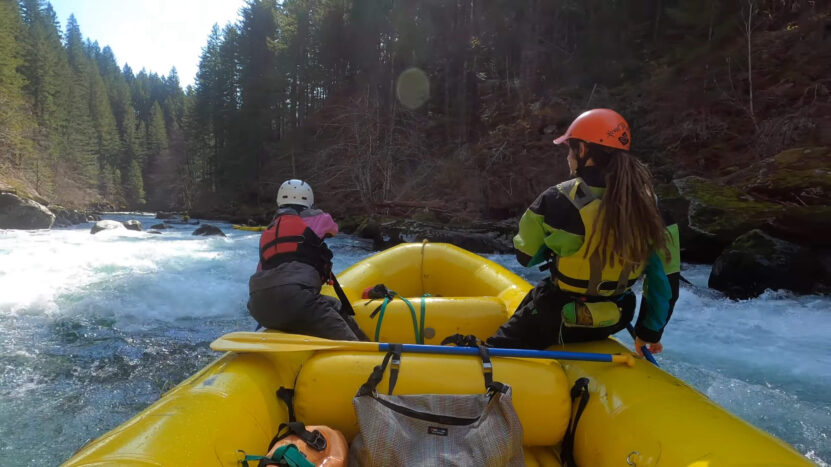
Without clear signals and constant feedback, you’ll struggle to stay on course, especially when things get intense on the river.
Establish Commands Early
Keep it basic. Commands like “left,” “right,” and “stop” should be clear and direct. You don’t want to waste time discussing things when you’re already in a rapid.
Use Short, Clear Phrases
River rapids are loud, and you won’t have time for long conversations. Short, loud commands get the job done without confusion. You’ll also have more focus on paddling instead of overthinking the communication.
Stick to single words like “paddle!” or “hold!” to signal actions. Avoid trying to explain too much—focus on making your instructions clear and fast.
Take Turns Leading
For example, if you’re coming up on a big rock, the person closest to it should tell the other when to paddle harder or stop. It’s about trust and being ready to take charge.
Stay Calm Under Pressure
When things get wild, it’s easy to panic, and communication can break down fast.
Keep your tone calm and controlled, even in stressful situations. You’ll make better decisions, and your partner will be able to follow instructions more easily.
Safety Tips
With a smaller crew, there’s more responsibility on each paddler to keep things under control. Here are some key tips to keep you safe out on the water.
Always Wear Your Gear
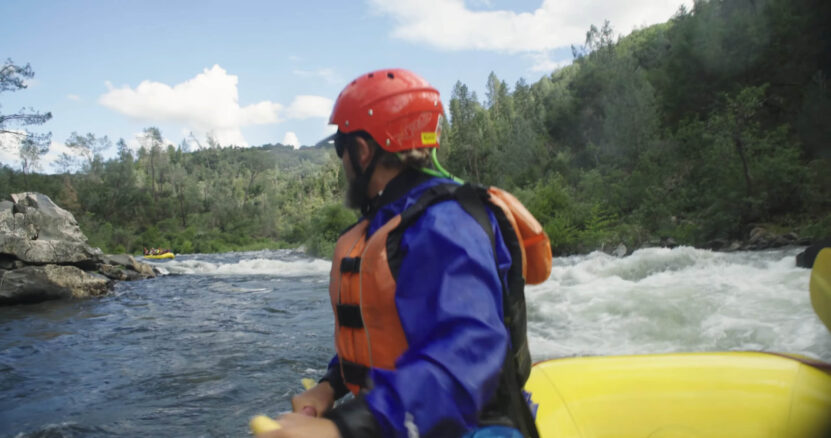
Helmets and life jackets (PFDs) are non-negotiable. Even if you’re a strong swimmer, the current can be unpredictable, and rocks are a real danger.
Double-check that your helmet fits snugly and your PFD is properly fastened. Test your gear before getting in the water to make sure it’s all set.
Know Your Limits
R2 rafting can get intense, especially in higher-class rapids (Class IV and V). Pushing yourself too far too soon can be dangerous. Start with easier rivers until you’re confident in your skills.
Choose rivers that match your skill level. If you’re still learning, stick to Class II or III rapids. Only move up when you’ve mastered the basics of synchronization and steering.
Practice Flipping and Recovery
Smaller rafts are more prone to flipping, and knowing how to recover quickly can make all the difference. The last thing you want is to panic when the raft flips over.
Practice flipping the raft in calm water so you know how to handle it if it happens in rougher conditions. Learn how to get back into the boat and how to help your partner do the same.
Scout the River Beforehand
You should know what’s ahead before you enter any rapids. Scouting the river allows you to identify potential hazards like rocks, drops, or tricky turns.
Get out of the boat and walk along the bank to check the rapids before you run them. Look for obstacles and plan your moves ahead of time. Communication with your partner during this part is crucial.
Use a Throw Bag for Rescues
If someone falls out of the boat, a throw bag can be a lifesaver. It’s a rope you can toss to pull someone back into the raft, preventing them from drifting downstream.
Always have a throw bag accessible and know how to use it. Practice throwing it accurately before you need to rely on it in an emergency.
FAQs
How long does an R2 rafting trip usually last?
R2 rafting trips can vary depending on the river and section you’re paddling. Most half-day trips are around 3 to 4 hours, while full-day trips can be 6 to 8 hours.
Multi-day trips are also an option if you’re on a long river with multiple rapids.
Can beginners try R2 rafting?
Yes, beginners can try R2 rafting, but it’s recommended to start on rivers with Class II or III rapids.
These are more manageable and less intense than Class IV or V rapids. Make sure you’re with an experienced partner if it’s your first time.
What’s the best season for R2 rafting?
The best season depends on the river. In general, late spring through early summer is ideal for many rivers because of snowmelt, which increases water flow.
However, some rivers, like the Ocoee, have regulated water releases and can be rafted through summer into early fall.
What should I wear for R2 rafting?
Wear quick-drying clothes like synthetic shirts and shorts, and avoid cotton because it stays wet and cold. Neoprene wetsuits and booties are ideal for colder rivers. Bring a windbreaker or splash jacket to stay warm in colder conditions.
Is there an age limit for R2 rafting?
Age limits vary by location and difficulty of the river. For easier rivers with Class II rapids, kids as young as 10 may be allowed, while more challenging rivers may require participants to be at least 16. Always check with the specific rafting company for their age requirements.
Last Words
R2 rafting offers a unique and thrilling experience, where teamwork and communication between two paddlers are key to success.
From picking the right gear and mastering essential techniques to choosing the best rivers and ensuring safety, this guide has everything you need to get started.

